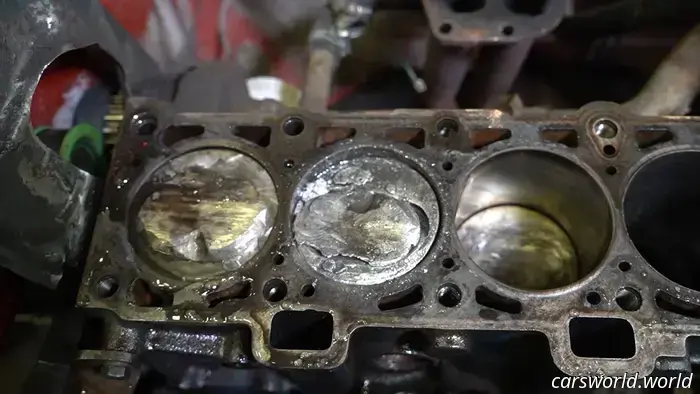
Doubling the Compression Ratio of a Gas Engine Leads to Unpredictable Outcomes.
Garage 54/YouTube
Raising an engine's compression ratio is a well-known method to boost horsepower, but there comes a point where the benefits taper off. The crew at Garage 54, the Russian mechanics who constructed a V16 from chainsaw engines, explored this concept by doubling the compression ratio of an aging Lada Samara four-cylinder to determine its limits and the consequences of excessive modifications. Spoiler alert: the outcome is not pretty.
The initial phase of the project was quite simple. One of the mechanics took off the cylinder head, a relatively easy task on a decades-old Lada hatchback, filled the combustion chambers with clay, and reassembled the engine. He then manually turned the engine several times to open and close the valves, creating impressions in the clay, which were cleverly used as a reference point. While this method isn’t the most sophisticated or precise for measuring an engine's compression ratio, it was effective.
By removing 1.25 millimeters from the cylinder head and carefully welding an aluminum plate atop each piston, the compression ratio increased from 9:1 to 22:1. However, the Garage 54 team deemed that ratio too high and added a second head gasket to bring it back down to 16:1. Surprisingly, the engine started! It was noisy, but it ran smoothly and idled remarkably well.
Then came the pivotal moment: could it drive? The answer is both yes and no. It could move under its own power, but during an acceleration test, the engine failed, which was somewhat predictable. Parts of the aluminum welded to the piston detached, and one piston split in half—even with 100-octane fuel. So, Garage 54 took a practical approach: they removed the broken piston, raised the compression ratio back to 22:1, and reassembled the engine. This unfortunate Lada is now equipped with a three-cylinder engine that has more than double the original compression ratio.
The engine doesn’t last long. It starts, runs (if that can be called running), and then fails spectacularly. Interestingly, the cause of its demise isn’t the elevated compression ratio; it’s the knocking from using the wrong fuel type. Garage 54 stops the experiment there but notes that increasing the compression ratio isn’t out of reach; it simply requires more extensive modifications, like upgraded rods. Could this be a hint at the next phase of the project?
Have any tips? Send them to [email protected]


Other articles
 GM Will Nullify the Warranty on Your Corvette ZR1 if You Resell It.
Considering selling a ZR1 within a year of buying it? Be prepared for the buyer to dislike you due to GM's "gotcha!" resale policy.
GM Will Nullify the Warranty on Your Corvette ZR1 if You Resell It.
Considering selling a ZR1 within a year of buying it? Be prepared for the buyer to dislike you due to GM's "gotcha!" resale policy.
 Willow Springs Raceway Will Close This Summer for Upgrades, Price Increases Expected: Sources
A source informs us, “The typical car enthusiast should get ready to bid farewell to Willow before July 2025.”
Willow Springs Raceway Will Close This Summer for Upgrades, Price Increases Expected: Sources
A source informs us, “The typical car enthusiast should get ready to bid farewell to Willow before July 2025.”
 In contrast to Ferrari, Maserati’s new customization program will embrace unconventional preferences.
Maserati's new "Fuoriserie" program allows you to choose what you want without limitations. In fact, it can even create a pink car for you.
In contrast to Ferrari, Maserati’s new customization program will embrace unconventional preferences.
Maserati's new "Fuoriserie" program allows you to choose what you want without limitations. In fact, it can even create a pink car for you.
 Mercedes-AMG Aims to Shift Focus from the EQC with This New Electric Vehicle | Carscoops
The Mercedes-AMG GLC EV will utilize the new MB.EA platform and is anticipated to deliver impressive performance.
Mercedes-AMG Aims to Shift Focus from the EQC with This New Electric Vehicle | Carscoops
The Mercedes-AMG GLC EV will utilize the new MB.EA platform and is anticipated to deliver impressive performance.
 Rolls-Royce Wraith Venuum: A Snake-Skin-Accented Dream for Influencers | Carscoops
Widebody Rolls is here to quickly boost your TikTok fame.
Rolls-Royce Wraith Venuum: A Snake-Skin-Accented Dream for Influencers | Carscoops
Widebody Rolls is here to quickly boost your TikTok fame.
 G-Power Believes This BMW M3 Touring Is the Perfect Wagon | Carscoops
A new set of turbochargers and an enhanced exhaust system enable this M3 Touring to reach a top speed of 205 mph.
G-Power Believes This BMW M3 Touring Is the Perfect Wagon | Carscoops
A new set of turbochargers and an enhanced exhaust system enable this M3 Touring to reach a top speed of 205 mph.
Doubling the Compression Ratio of a Gas Engine Leads to Unpredictable Outcomes.
The clever mechanics succeeded in getting the engine to start and run smoothly, but the celebration was short-lived.
